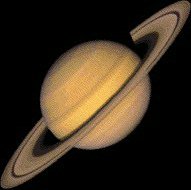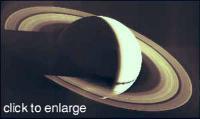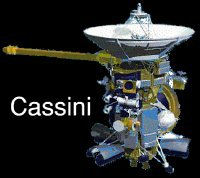
 |
Saturn - ringed beauty |
|
| |
 Vital StatsThere are 22 moons orbiting the planet, 4 of which were discovered in summer 2000. Only nine are particularly significant. Titan is the largest (diameter 5,150km), and is the only planetary satellite known to have an atmosphere, mainly nitrogen. In January 2005 the Huygens probe landed on Titan, having travelled on board the Cassini probe which entered orbit around Saturn in 2004. Day & Night Just like all the other planets, Saturn is visible because it reflects the Sun's light. In this photo (by Voyager 2), the sunlight is coming from the right. The left side of the planet is in shade: night. It is more noticeable because the ring is also in shadow. Just like all the other planets, Saturn is visible because it reflects the Sun's light. In this photo (by Voyager 2), the sunlight is coming from the right. The left side of the planet is in shade: night. It is more noticeable because the ring is also in shadow.
Ringed Beauty The planet has an extensive system of rings, composed of icy particles ranging in size from pebbles to beach balls. These rings appear from Earth as distinct bands with divisions between them, named after the astronomers who first discovered them. Spacecraft photographs reveal many more such bands with finer detail. The ring thickness is also no more than 150m, with their temperature in sunlight at around -180°C and as low as -200°C in shadow. A number of smaller moons lie within the ring system and influence the rings. For example, Prometheus and Pandora, are seen to "shepherd" the particles of a ring held between them. The planet has an extensive system of rings, composed of icy particles ranging in size from pebbles to beach balls. These rings appear from Earth as distinct bands with divisions between them, named after the astronomers who first discovered them. Spacecraft photographs reveal many more such bands with finer detail. The ring thickness is also no more than 150m, with their temperature in sunlight at around -180°C and as low as -200°C in shadow. A number of smaller moons lie within the ring system and influence the rings. For example, Prometheus and Pandora, are seen to "shepherd" the particles of a ring held between them.
Exploring the Solar System If you'd like to explore Saturn further, you could do much worse than check out Giles Sparrow's book! If you'd like to explore Saturn further, you could do much worse than check out Giles Sparrow's book!
Join him (UK | US) on an imaginary tour of this wondrous planet. Then sit back and enjoy the data from Cassini and Huygens for years to come. |
Under StudyAfter a brief fly-pass by Pioneer 11 in 1979, Voyagers 1 and 2 sent back much important information about the planet, its satellites and rings during their encounters in 1980 and 1981. Click here for Voyager 2 Schematics. Cassini & Huygens The Cassini probe, launched in October 1997, entered orbit around Saturn in July 2004, the first probe ever to do so. It is named after the Italian-born French Astronomer Giovanni Cassini (1625-1712), discoverer of the major gap (see photo) in Saturn's rings; the Cassini Division. The Cassini probe, launched in October 1997, entered orbit around Saturn in July 2004, the first probe ever to do so. It is named after the Italian-born French Astronomer Giovanni Cassini (1625-1712), discoverer of the major gap (see photo) in Saturn's rings; the Cassini Division.
Where is Cassini Now?Click here to track Cassini's progress around Saturn.A Typical GiantThe composition of the planet is very similar to that of Jupiter, with a silicate core surrounded by liquid hydrogen, and a deep gaseous hydrogen atmosphere. This atmosphere is cooler than Jupiter's, and, while displaying similar banding, the colouring is less vivid, due to a haze of ammonia crystals at its outer reaches. Wind speeds of up to 1,400 km/h have been detected, giving an indication of extreme meteorological activity. |
|
Sun | Mercury | Venus | Earth | Moon | Mars | Asteroids | Jupiter | Saturn | Uranus | Neptune | Pluto | X | Kuiper | |